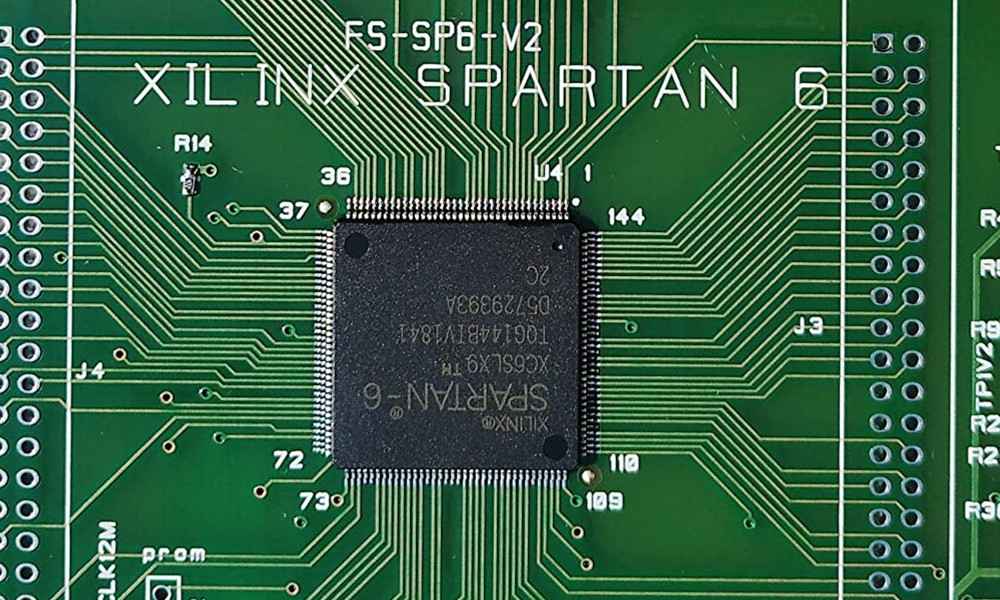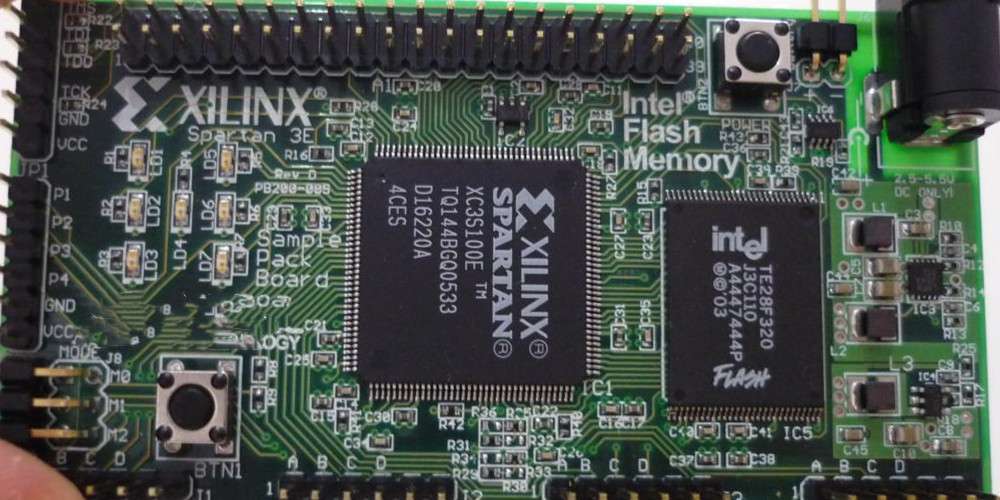Xilinx is a global leader in complete programmable logic solutions. Today, there are different applications associated with field programmable gate arrays (FPGAs). Xilinx has grown in complexity and capability over time. Therefore, this global leader keeps inventing and introducing new FPGA boards in the industry.
The Xilinx Spartan is an exceptional and well-admired FPGA board. Also, the FPGA industry has tried to keep its pace. FPGAs have been designed for various applications over time. These FPGAs vary in terms of their specific designs, high gate count, and low power consumption. One of such FPGAs that offer these capabilities is the Xilinx Spartan.
What does Xilinx Spartan Offer?
Xilinx developed Spartan in the 2000s and ever since there has been more development. Spartan was specially designed to respond to an increasing demand from FPGA users. Therefore, this gave birth to development of Spartan. Also, this resulted in the ease linked to programming and the reliability of Xilinx as regards power consumption.
Xilinx Spartan is suitable for a vast range of applications. Xilinx Spartan offers solutions to the increasing demands of the FPGA industry. You will find the Spartan FPGAs in products designed by industry-leading manufacturers. Furthermore, Xilinx is the first choice of most engineers due to its special capabilities like high performance and low power consumption.
As a result of its capabilities, Xilinx Spartan has gained popularity over time. This board is here to stay. FPGAs usually feature large-scale programmable logic devices which include several I/O pins. The Xilinx Spartan is a low power consumption, low cost, and logic-optimized FPGA family that offers comprehensive connectivity.
Furthermore, Xilinx Spartan is an FPGA family that features several FPGA series. The Xilinx Spartan series incorporates a standard FPGA structure. Xilinx Spartan ranges from Spartan 3, Spartan 5, Spartan 6, and more. Xilinx Spartan features configurable logic blocks positioned in routing channels.
Benefits of Xilinx Spartan

Xilinx Spartan FPGA provides a wide range of advanced features. These features contribute to the performance of Spartan in applications. Therefore, Spartan has been able to proffer perfect solutions for some high-volume and cost-sensitive applications.
Enhanced security
Xilinx Spartan features enhanced security which enables design protection. Of course, design protection is an integral aspect of some applications. Also, Xilinx Spartan has continued to improve its security from series to series. For instance, Xilinx Spartan 6 features a Device DNA identifier for authenticating a design.
Low cost
Xilinx Spartan was primarily designed for low cost. Therefore, Spartan comprises various integrated blocks and a wide range of I/O standards. In addition, these features provide solutions for high performance applications.
Simplified configuration
Xilinx Spartan features a simplified configuration which offers support for low-cost standards. In addition, this FPGA features a Multiboot that provides supports for remote upgrade. Also, the DSP performance allows simplified configuration in Xilinx Spartan.
Low dynamic and static power
Xilinx Spartan provides low dynamic and static power. For instance the Spartan 6 provides 45nm process technology for low power consumption and low cost. Furthermore, the FPGA features a Suspend mode that allows configuration with several pin wake-up. Also, the high performance 1.2V core voltage and the low power 1.0V core voltage ensure low dynamic and static power.
BOM cost reduction
Xilinx Spartan offers reduction in the cost of BOM. For instance, the Xilinx Spartan 7 features SYSMON and XADC to monitor the circuitry and the incorporation of discrete analog. Also, the cost-optimized feature enables system input/output expansion.
Supports different applications
Xilinx Spartan offer support to different applications. This FPGA is suitable for different applications like communication and computing equipment. Also, the family offers support to various protocols and provides many building block components.
Xilinx Spartan FPGA Configuration

Xilinx Spartan configuration is a simple process. Spartan saves the configuration data in the internal latches of SRAM. Furthermore, the configuration bits is within the range of 3Mb and 33 Mb. But, this depends on the user-design implementation alternatives and the size of the device.
Anytime you power Xilinx Spartan, you need to reload the configuration storage. There are various data methods and formats for loading configuration. The bit-serial configuration can remain in the master serial mode when Spartan generates the CCLK signal.
For Xilinx Spartan, there are two common methods of configuration. These methods are the Master Serial Peripheral Interface (SPI) and the Master Byte-wide Peripheral Interface (BPI). Xilinx Spartan is capable of configuring itself.
The configuration process in Xilinx Spartan clears the whole configuration memory. After that, it loads the configuration data starting with the bus-width detection pattern. Then, it detects low power-up and checks the mode pins to ascertain if the configuration mode is bit-serial or parallel or slave or master.
Also, some Xilinx Spartan FPGA series support MultiBoot configuration. Also, a MultiBoot Configuration enables users to store two or more configuration bitstreams in one configuration source.
Input/Output of Xilinx Spartan
The Input/output pins are a fundamental element of Xilinx Spartan FPGA. The number of input/output pins varies based on Xilinx Spartan series. Also, the device size and package size determine the number of I/O pins. Furthermore, you can configure each I/O pin. You can also comply the pins with a vast number of standards. The SelectIO of Xilinx Spartan defines the input/output capabilities of the various I/O options.
All package pins comprise similar I/O capabilities apart from the dedicated supply pins and configuration pins. Furthermore, all user I/O pins in Spartan are bidirectional. Therefore, there are no input-only pins. Also, all input/output pins are in banks. Each bank comprises Vcco output supply-voltage pins.
There are several dual-purpose pins in each bank. You can distinguish Xilinx Spartan series by the number of I/O pins they comprise. Each Xilinx Spartan includes several I/O features that system designers can integrate in every I/O in their designs.
Features of Xilinx Spartan
Xilinx Spartan comes with several features like
Logic capabilities
Xilinx Spartan’s programmable logic includes resources like memory blocks, DSP slices, and mega-flops. Mega-flops are a logic unit that executes one-million operations per second. Also, you can use these FPGA logic resources with several combinations in order to meet various design needs.
Optimized logic design
Spartan features optimized logic design that utilizes Xilinx tools. In addition, this minimizes the logic amount needed to provide a task.
High throughput memory blocks
Xilinx Spartan supports large RAM blocks. These blocks can store data. For instance, a block with a 1GB data can store large data amounts during FPGA simulation. In addition, you can uninstall your RAM block from its primary computation region. Also, this helps in accessing the memory block.
Vivado development process
Vivado is an upgrade in Xilinx Spartan 7. The routing technology and expert-level placement offered by Vivado enable faster timing closure. Also, there are several design reuse functions that can package a part of the IP built for a particular device.
Versions of Xilinx FPGA Spartan

Xilinx Spartan features several versions. The Spartan family is an integral part of everyday applications.
Xilinx Spartan 2
Xilinx Spartan 2 features six-family members. Also, the lowest member of this family features a 15,000 system gate density. The highest member features a gate density of 200,000. Furthermore, system performance offers about 200MHz. Spartan 2 features four DLLs, 56 Kbits block RAM, and 16 I/O standards.
Spartan 3
This Spartan series is crucial for incorporating the Xilinx Virtex-E FPGA and Accel-FPGA device in the hardware. Also, Xilinx Spartan 3 enables a RAM module that helps memory storage from Xilinx library. Therefore, the RAM block sits between the SRAM blocks and the processor.
Spartan 3A
Xilinx Spartan 3A comprises a fully optimized I/O that ranges from 195 to 375 I/Os. Also, it consists of 4 devices with a system gate that ranges from 200 to 1.4 million. Xilinx Spartan 3A is well-suited for I/Os electronic operations.
Spartan 3E
The Spartan 3E version is ideal for logic gate-centered designs. This FPGA prioritizes cost while maintaining overall performance in these designs. Also, Spartan 3E supports I/O features of about 66 to 376 I/Os. In addition, Spartan 3E is ideal for use in automotive networking and video processing.
Spartan 3AN
This Spartan family features upgraded capabilities of Spartan 3A. Spartan 3AN comprises the onboard flash memory, the SPI, and the SPI memory. Also, Spartan 3AN is a low-cost platform that features SRAM-based FPGA.
Spartan 5
This Spartan series provides solution to the processor heating problem. Also, heat pipes link the processor and provide high-efficiency cooling for processor types. Xilinx Spartan 5 features improved processor installation. Also, it features advanced RAM module compatibility.
Spartan 6
Xilinx Spartan 6 is an advanced FPGA that solves the problems of the previous versions. This FPGA version supports high connectivity features like 6-input LUT and microblaze soft processor. Also, Spartan 6 features high logic-to-pin ratio, a sizeable form factor, and SDRAM memory controllers.
Spartan 7
Spartan 7 is the most recent version. This Spartan version recorded huge sales in 2020. Also, Spartan 7 consumes the lowest power and offers the highest performance. Xilinx Spartan 7 is budget-friendly for system I/O expansion.
Difference Between Xilinx Spartan 6 and Spartan 7
As we all know, Xilinx Spartan is available in several series. Xilinx Spartan 6 and Spartan 7 are the most recent Spartan FPGAs. The Spartan 7 succeeds Spartan 6. The semiconductor technology evolved vastly since the advent of Spartan 6. Upgrading from Spartan 6 involves improving FPGA development tools in Spartan 7.
Furthermore, the Spartan 7 utilizes Vitis toolset and Vivado ML. Vivado encompasses the features and capabilities responsible to the efficiency of ISE.
Block RAM
Spartan 6 devices features the 45nm technology. However, Spartan 7 capitalized on this feature. Therefore, the 28nm technology featured by Spartan 7 offers a 30% increase in performance speed. Also, Spartan 7 FPGAs offer lower power consumption compared to its predecessor. Spartan 6 features an 18-Kbit blocks configured as two 9-Kbit blocks. However, the Spartan 7 upgraded to 36-Kbit blocks configured as two 18-Kbit blocks.
Each block RAM in Spartan 7 have higher capacity. This indeed is an improvement in itself. Also, Spartan 7 feature built in error correction coding and FIFOs.
Memory Interface
Spartan 6 utilizes an integrated memory block while Spartan 7 series utilizes a Soft IP core to integrate the memory controller. Therefore, this offers Spartan 7 devices more flexible approach to allocation and design of I/O which can be crucial when working with complex board designs. Spartan 7 memory interface controller offers support to DDR2, LPDDR2, DDR3l, and DDR3.
DSP slices
The DSP slices of 18 x 18 in Spartan 6 upgraded to 25 x 18 in Spartan 7 series. This feature is the key behind the integration of signal processing and mathematical functions. Also, the Spartan 7 indicates a dramatic performance boost.
Applications of Xilinx Spartan FPGA
Xilinx Spartan FPGA is widely used in several applications. Spartan FPGAs have continued to meet the increasing demands of low cost, high-performance applications. Also, the continual upgrade of Spartan FPGA series has contributed to this achievement. Therefore, Xilinx Spartan is ideal for use in the following applications:
Industrial networks
These days, factories are configurable and automated. The technology behind the center of these factories is Industrial Ethernet. Also, this provides positive communication across the networked devices of the system. Xilinx Spartan FPGA enables designer execute Ethernet switches due to its high performance logic. Therefore, this enables deterministic communication when the nodes of the network grow.
Also, the programmable logic allows designers to integrate motor control and interfaces. The programmable logic enables the integration of several protocols on a hardware platform. Also, Xilinx Spartan features high efficiency algorithms that enable motor control.
Machine vision interfacing
Xilinx Spartan features adaptive SoCs and FPGAs that enable high-performance and compact industrial cameras. This provides visual intelligence required by customers to help distinguish their imaging products. Also, Xilinx Spartan offers support for the sensor interfaces and main camera.
Computing and communication equipment
Xilinx Spartan FPGA 3 is crucial for computing and communication equipment. The Spartan family offers great performance at a very low cost in this application.
